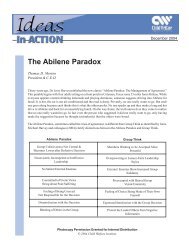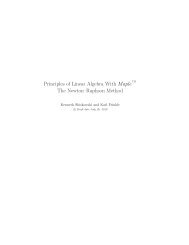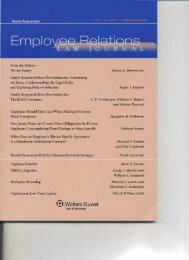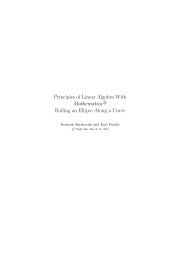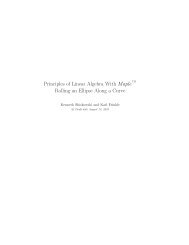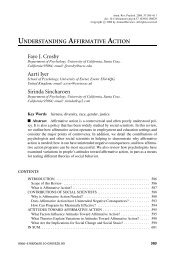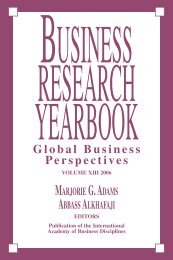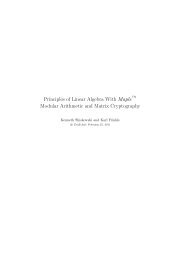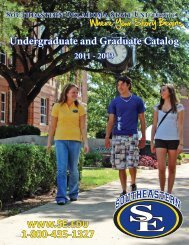Do Nice Guysâand GalsâReally Finish Last - Southeastern ...
Do Nice Guysâand GalsâReally Finish Last - Southeastern ...
Do Nice Guysâand GalsâReally Finish Last - Southeastern ...
You also want an ePaper? Increase the reach of your titles
YUMPU automatically turns print PDFs into web optimized ePapers that Google loves.
4 JUDGE, LIVINGSTON, AND HURST<br />
Hogan’s (1983) socioanalytic theory and Barrick, Stewart, and<br />
Piotrowski’s (2002) results suggest that personality may affect<br />
choice of situations (J. Hogan & Holland, 2003)—in this case that<br />
agreeable individuals, being more motivated to “get along” than<br />
“get ahead,” may choose to work in lower status, more serviceoriented<br />
occupations. Finally, regarding the final and focal relationship<br />
(differential effect of agreeableness on income for men vs.<br />
women), it is possible that the differential association of agreeableness<br />
with income for men and women might be affected by<br />
job and occupational characteristics. In short, it is possible that<br />
agreeableness disproportionately affects men’s earnings because<br />
agreeable men (as opposed to disagreeable men) are less likely to<br />
pursue prestigious work.<br />
Accordingly, in the third study, we tested the hypotheses controlling<br />
for various job and occupational characteristics. Across all<br />
three field studies, we included three relevant control variables:<br />
educational attainment, marital status, work history, and hours<br />
worked to control for possible third-order variables that may be<br />
related to gender, agreeableness, and earnings. Below, we introduce<br />
the individual studies and the nuances of each approach.<br />
Study 1<br />
In Study 1, the hypothesized relationships among gender, agreeableness,<br />
and income are tested on a large sample of working<br />
adults. In addition to the aforementioned control variables, Study<br />
1 also controls for two other Big Five traits: neuroticism and<br />
extraversion. Neuroticism is a trait (along with agreeableness) that<br />
demonstrates the most consistently large gender effects over time<br />
(Bouchard & Loehlin, 2001), such that men are less neurotic than<br />
women. Additionally, neuroticism (or its converse, emotional stability)<br />
and extraversion have been found to be related to career<br />
success (e.g., Ng et al., 2005). Thus, controlling for these traits<br />
allows us to exclude two potential confounding factors. We also<br />
control for income at the time agreeableness was measured, so that<br />
gender, agreeableness, and their interaction predict prospective<br />
changes in income.<br />
Method<br />
Participants and procedure. Participants in Study 1 were<br />
individuals enrolled in the National Longitudinal Surveys of Youth<br />
(NLSY97). The NLSY97 is sponsored by the Bureau of Labor<br />
Statistics, U.S. Department of Labor, and conducted by the National<br />
Opinion Research Center (NORC) at the University of<br />
Chicago with assistance from the Center for Human Resource<br />
Research (CHRR) at The Ohio State University. The NLSY97<br />
consists of a nationally representative sample of approximately<br />
9,000 youths who were aged 12–16 years at the initiation of the<br />
study in 1997. Since 1997, participants have been interviewed<br />
annually, although 2008 is the most recent year for which data are<br />
available. Although the primary focus of the NLSY97 was to<br />
document the transition from school to the labor market, in 2002,<br />
data on participants’ personalities were collected.<br />
Most interviews were conducted in participants’ households (in<br />
the relatively small [approximately 13%] of cases where this was<br />
not possible, participants were interviewed over the phone). Participants<br />
were provided small (typically $10) incentives for participating<br />
in each round of interviews. Naturally, some sample<br />
attrition occurred over time, although the level of attrition was<br />
relatively low, averaging roughly 2% per time period. Because<br />
many of the participants were of college age over the time period<br />
when income was assessed, we limited the study to those individuals<br />
who were (a) working outside the home, (b) not enrolled in<br />
college full-time, and (c) working at least 1,000 hr per year. These<br />
restrictions reduced the sample size to N 560.<br />
Measures.<br />
Agreeableness. We measured participant agreeableness by<br />
their responses to three questions that were asked in the 2002<br />
survey. These three questions were (a) “How much do you feel that<br />
agreeable describes you as a person, where 1 means quarrelsome<br />
and 5 means agreeable?” (b) “How much do you feel that difficult<br />
describes you as a person, where 1 means cooperative and 5 means<br />
difficult?” and (c) “How much do you feel that stubborn describes<br />
you as a person, where 1 means flexible and 5 means stubborn?”<br />
The last two items were reverse-scored, and then the three responses<br />
were averaged. The coefficient alpha reliability estimate<br />
of this scale was .79. 1<br />
Neuroticism and extraversion. Neuroticism was measured<br />
with a four-item scale ( .77) on the 2002 survey: (a) “How<br />
much of the time during the last month have you been a very<br />
nervous person?” (b) “How much of the time during the last month<br />
have you felt calm and peaceful?” (c) “How much of the time<br />
during the last month have you felt downhearted and blue?” and<br />
(d) “How much of the time during the last month have you been a<br />
happy person?” Responses to these questions were evaluated on a<br />
4-point scale (1 all of the time, 2 most of the time, 3 some<br />
of the time, 4 none of the time). Responses to the second and<br />
fourth questions were reverse-scored, and then participants’ responses<br />
were averaged. Extraversion was measured with a twoitem<br />
scale ( .43), completed in 2008, where participants<br />
evaluated how well two pair of traits (“extraverted, enthusiastic”<br />
and “reserved, quiet”) described them. Responses were anchored<br />
ona1(disagree strongly) to7(agree strongly) scale. For the<br />
extraversion scale, responses to the second item pair were reverse<br />
scored, and responses to the two items were averaged.<br />
Sex. Participants’ sex was noted by the interviewer in the<br />
initial interview and was coded 1 male, 2 female.<br />
Education, marital status, hours worked, and work history.<br />
Participant education was measured with a variable that was created<br />
to reflect, on an ordinal scale, the highest degree received as<br />
of 2004. Responses ranged from 0 (none) to7(doctoral-level<br />
degree). Marital status was measured by the interviewer recording,<br />
during the 2003 interview, whether the participant was married or<br />
had a partner in the household (coded 1) or was single, divorced,<br />
1 We investigated the convergent validity of this measuring using an<br />
independent sample of 914 students enrolled at a <strong>Southeastern</strong> university<br />
(M age 20.45; 55% female). The correlation between this agreeableness<br />
scale and John’s (1990) agreeableness subscale of the Big Five Inventory<br />
(BFI; .77) was significant (r .56, p .01). To compare this<br />
convergent validity to other agreeableness measures, we searched the<br />
literature and obtained 53 convergent validity coefficients from 23 articles.<br />
(A list of the studies included in this analysis is available from the authors.)<br />
Averaging across these 53 correlations, the average convergent validity<br />
was r .55 (r .14). Thus, the convergent validity for the Study 1<br />
agreeableness measure is quite similar to the typical convergent validity<br />
between agreeableness measures reported in the literature.



